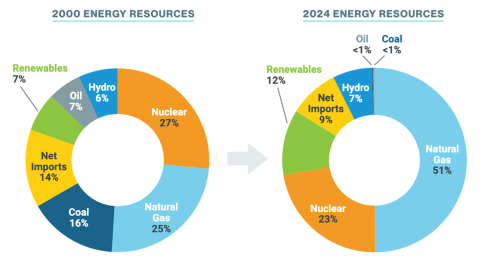New England is determined to shift toward a greener electric grid, but the region’s plan to slash its current reliance on natural gas (and backup fuel oil — and sometimes coal) by ramping up offshore wind and solar (and backup batteries) has hit a seemingly immovable object. President Trump, a staunch opponent of offshore wind, on Day 1 of his second administration ordered a halt to new leases and permits and directed his Interior Secretary to review existing permits. As we’ll discuss in today’s RBN blog, those moves have left New England power planners scratching their heads, and may even resurrect the possibility of expanding natural gas pipeline capacity into the region.
New England’s energy path the past few decades has been as twisty-turny as a gravel road through the Green Mountains of deepest, darkest Vermont. First the rallying cry was “No nukes!” — from the early 1990s through the late 2010s, six of the region’s eight nuclear plants were shut down. Then it was “No fossil fuels!” Sign-wielding protesters in the proudly progressive region blocked most — but not all — energy-industry efforts to enable more natural gas to be piped in from the nearby Marcellus Shale to fuel new gas-fired power plants (and allow older, dirtier coal- and oil-fired units to be retired). “More renewables!” has been a long-standing call to action too. Scores of new solar farms and a handful of wind farms (almost all of them onshore) have been developed, and plans made for a slew of large, offshore wind farms that many thought would make New England a sort of “Denmark-in-the-States.”
New England’s energy reality today is an electric grid that functions very well most of the time, primarily dependent on a mix of gas-fired power, nukes, solar, wind and hydroelectricity (some within the region and some imported from Quebec), solar and onshore wind — plus a heavy dose of energy efficiency that reflects the region’s deeply ingrained frugality. But for at least a few days each winter — and sometimes a couple of weeks — grid operators at ISO New England (ISO-NE) are on tenterhooks when the temperatures turn frigid, the snow piles up, the winds howl and most of the natural gas flowing into the region is used for space heating, leaving many gas-fired power plants with only a fraction of the gas they would need to run flat-out. That’s led to the now-widespread stockpiling of backup fuel oil (at dual-fuel plants) or LNG (at gas-only plants) that operators can turn to when pipeline gas is in short supply.
No fewer than six questions need to be answered:
- How has New England’s power-generation mix evolved over the past 25 years?
- What is the region’s generation mix today?
- What goals have the states set for decarbonizing the power sector?
- What is the plan for meeting those goals?
- How will President Trump’s adamant stance against offshore wind — and for fossil fuels and deregulation — impact that plan?
- How will grid operators maintain system reliability under this new reality?
We’ll cut to the chase on each of these. As shown in Figure 1 below, gas-fired plants (light-blue slices) generated 25% of New England’s power needs in 2000 and just over half (51%) in 2024 as a slew of coal-fired (dark-blue slices) and oil-fired (gray slices) generation was either retired or relegated to emergency-only use. Also, several nuclear plants — including Vermont Yankee (in 2013) and Pilgrim (in Massachusetts, in 2019) — were permanently removed from service, leaving only Millstone (in Connecticut) and Seabrook (in New Hampshire) running, and trimming nuclear’s contribution to regional generation (orange slices) to 23%.
New England’s Power Generation Mix, 2000 vs. 2024
Figure 1. New England’s Power Generation Mix, 2000 vs. 2024. Source: ISO New England
Join Backstage Pass to Read Full Article











